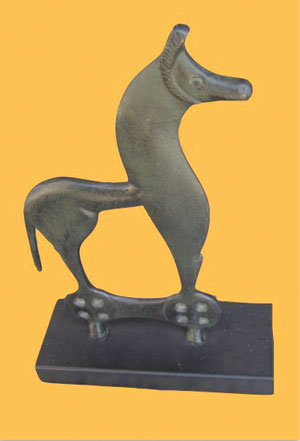
In Tuscany, in the Province of Pisa in Etruria, lies the ancient city of Volterra. In the 8th century BCE the city operated as an important Etruscan center. Many today know the city as the center of the Volturi Vampire Clan in the Twilight Saga’s New Moon, as well as numerous Etruscan ruins.
Enthusiasts of all things Etruscan visit the Etruscan walls built 2,300 years ago, the Porta dell Arco, as well as Etruscan baths, an aqueduct, an amphitheater and Etruscan burial sites. Since that civilization is so old and so mysterious, collectors long for a piece of it.
Gunilla sends me this little mid-century Etruscan style bronze horse. The original design refers to Pre-Hellenic 2800-800 BCE (think Trojan horse). The people of Volterra show pride in their long Etruscan heritage. Gunilla’s sculpture gives such an example, which has historical resonance, and a tradition of fakery.
Paulo Simoncini’s foundry in Volterra bases Gunilla’s horse on the versions of the Etruscan geometric horse bronzes in the British Museum Collection. Etruscan civilization’s tradition for figurative sculpture in terracotta, cast bronze, wall paintings and metal working, flourished between the 9th and 2nd century BCE. The tradition absorbed into the Roman culture later. The British Museum acquired important Etruscan material dug up from Etruscan tombs located on the property owned by Lucien Bonaparte, younger brother of Napoleon. I find it difficult to understand why the British Museum actively purchased grave site material in the 1830’s through the 1840’s, but “acquire” they did.
Forged Artworks
Fitzwilliam Museum at Cambridge reports that Etruscan material possess a long tradition for forgeries. They should know. In 1946, the Fitzwilliam Museum purchased a pair of Etruscan bronzes which a scholar in Germany in 1964 unmasked as fakes. Other Etruscan fakes, thought authentic 5th century BCE objects reside at the Metropolitan Museum of Art, and are actively shown in many other public and private collections. It took the Fitzwilliam 22 years to “pull” their mistake.
In the 18th century collectors started to view ancient Etruscan ruins as worthy of admiration for their evocative imagery of a lost heroic civilization. What once hindered a farmer’s plow in Volterra became hot property. Famous museums bought like mad. Gentleman collectors and savvy dealers made a lot of shady money in Tuscany this way. Interestingly the most notorious of all dealers were the Scots.
Paulo Simoncini
Likewise Gunilla’s Simoncini horse sculpture capitalizes on the glory of Etruria. The Simoncini family website credits the designer, Paulo, of this little horse sculpture, as the “heir of an ancient craft.” In an interesting yet unintentional “Goodfella’s” way, “Paulo,” the site goes on to says, “takes care of business and artistic activities” in the family studio. Watch out, Gunilla, I don’t recommend visiting anytime soon.
Paulo Simoncini designs include ibex, ducks, rabbits, deer, chimera, swans, owls, coins, mirrors, bowls, vases, goddesses, dancers and nude warriors, you name it, in the Etruscan style. With today’s craze for mid-century Modernism, Etruscan style geometric designs look fantastic. Thus Simoncini bronzes are hot. Gunilla, your little horse is worth $300 today. If you buried it for a few years, you might be able to make more – just kidding.